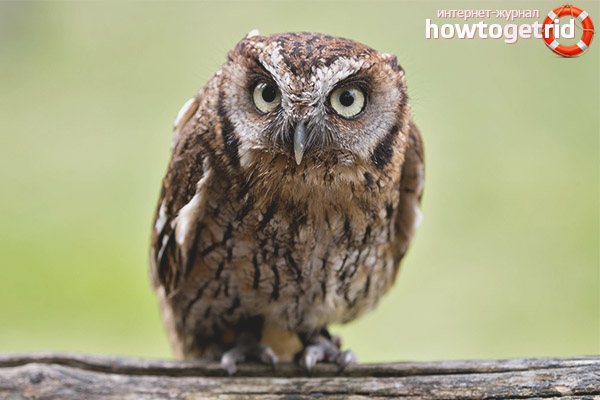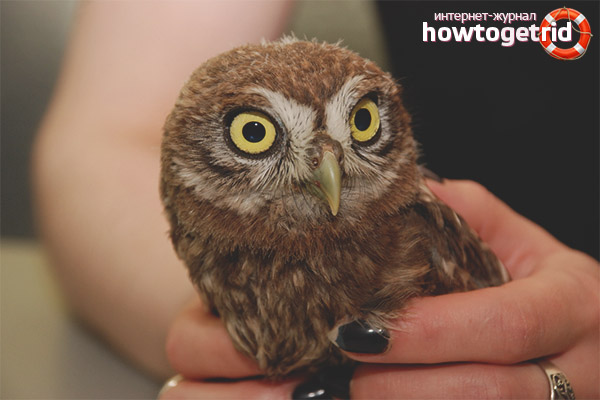The content of the article
Uspens is ranked among the smallest species of owls, whose populations can be found on the European mainland. These birds easily get used to home conditions; they willingly make contact with a person, allowing themselves to be tamed. This feature gives them popularity among fans of pets.
Distinctive features
This bird has a second name, which is voiced as a dawn, it belongs to a large group of owls, choosing semi-steppe areas located in southern Europe as their habitat.
In its daily diet, the bird prefers insects, it likes to hunt beetles, as well as butterflies or orthoptera, it rarely attacks vertebrate representatives. The average life span of an insectivorous bird is 6 years.
As a rule, the size of the backbone body reaches 21 centimeters, the weight of an adult does not exceed 130 grams, and the width of its wingspan is about 50 centimeters. In the plumage of the dawn, a gray-brown hue prevails, white spots are on her shoulders, her whole body is replete with dark stains of a flowing pattern, decorated with interspersed from bright points. The coloring of the plumage of a bird allows it to become invisible against the background of a tree bark. In total, there are 2 types of splyushki, they differ in color. Representatives of the red color are referred to the first, and gray to the second.
Two characteristic tufts of plumage are located on the head of the dawn; by their appearance they resemble jewelry, they are called ears. The bird’s eyes are rounded and have a bright yellow or orange color, the beak of this bird is painted in a dark shade. A silent owl is quite difficult to detect among the trees; its disguise is impeccable.
The bird got its name due to the special sound of its voice, in its singing the word "sleep" is clearly distinguishable, alternating with a bizarre whistle. The sound is repeated periodically with an interval of 2 seconds, like a cuckoo. In various regions of Europe, in the vast expanses of Asia, within the Caucasus and in the Balearic Islands, a number of subspecies belonging to this species of owls can be found.
Distinctive features of the dawn lifestyle and favorite habitats
This owl prefers deciduous trees, it can easily settle in the garden or in the park area, it is attracted to light forests, consisting of artificial plantings. Located in the Mediterranean regions, it prefers planting, consisting of olive groves, it is not afraid of its close proximity to humans, because most people are very loyal to night hunters.
Inhabited in mountainous regions, it can arrange its nests at an altitude of 3000 meters relative to sea level. Spyushka is classified as a migratory bird; for the winter season it has to fly to the zone of African tropical forests, which are located south of the Sahara.
The dawn enters the territory of the Russian Federation in early April, here it nests, raises offspring in order to make the next flight with the arrival of September.The little owl spends all day on the branches of trees, sensing danger, she uses interesting tactics. Having stretched out the body and "pricked up" the ears, the owl becomes strikingly similar to a dry branch of a tree, it is very difficult to distinguish it even from a short distance.
The period of nesting and hatching of chicks
Splyuska violates breeding immediately after returning to its homeland, birds living in the southern territories are ready to mate with the onset of February. She begins to arrange her nests from the beginning of May until the onset of July, and in some territories even later. To attract the female, the male makes invocation cries when she reciprocates, the birds populate the nest for a couple living, laying the dawn puts off once a season.
For its nest, the bird can adapt the hollow she likes or one of the crevices found in rocky surfaces. In addition, she can settle in nests left by magpies or other birds, and can also settle in a hole made by a kingfisher or bee-eater. Avian couples choose for their nesting sites certain areas where they live for a long time, their nests are created for more than one year.
An ordinary scoop has in its clutch from 2 to 6 eggs, covered with a white shell, the size of eggs is 3 centimeters, their weight reaches 15 grams. The incubation period of these birds lasts 25 days. A month after the birth of the strong chicks leave the nest. Hatching masonry is exclusively the female's concern, and both birds are engaged in feeding the babies, weaning for hunting in turn.
The body of little chicks is dressed in white fluff. After several weeks, the young growth acquires a light gray color of plumage, embellished with thin stripes located across. At this age, young individuals get out of the nest, learning the art of flight. The final formation process is completed at 45 days of age; by this period, young individuals, as a result of selective molting, become covered in adult coloration.
Features of singing dawn
Some species of male splyushki are able to publish a prolonged howl during the mating season, reminiscent of the howling of March cats. Others in South Africa express their feelings with intermittent murmurs, and there are those whose voice is very similar to the melody of a flute that sounds in high key.
Having reached agreement, a couple in love performs a mating motif in a duet, characterized by high professionalism of performance. Of course, the females voice is noticeably bass, but they keep the rhythm perfectly, in good weather, some individuals are carried away so much that they continue to perform the duet even in the daytime.
Recommendations for keeping a home scoop
Zorka is quite friendly to people, she easily accepts the conditions of guardianship and willfully takes a confident position in the family of her trustees. Keeping representatives of this species in captivity does not present certain difficulties; their eccentric behavior model can add a lot of positive emotions to the monotony of life.
Most often, the scoop is kept in a single copy, they quickly get used to their owners and answer them with sincere affection. But, if there was a desire to get a couple, then in this case a mini-aviary is needed for keeping birds. The minimum size of such a dwelling should be 1 cubic meter.Mandatory elements of such a living corner are: a hollow, which birds can use as a pantry, and a trunk with convenient branches, on which the birds will mask in the afternoon. The most interesting thing is to observe the behavior of birds in the evening, when they lead an active lifestyle.
It is rather difficult to distinguish birds by sex, due to the fact that the spatters have practically no external differences, the only difference is the size, the female, as a rule, is larger than the male. Captive-bred chicks adapt best to their home environment and are not afraid to let go of their cages. At the same time, they show a noticeable interest in the owner, scoops can take food from his palm, sitting comfortably on the finger. The unpretentiousness of this bird and, often, a very comical manner of its behavior, causes a special thrill to such pets.
Video: Splyushka (Otus scops)












Submit